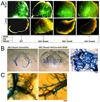Arteriovenous malformation in the adult mouse brain resembling the human disease
- PMID: 21437931
- PMCID: PMC3117949
- DOI: 10.1002/ana.22348
Arteriovenous malformation in the adult mouse brain resembling the human disease
Abstract
Objective: Brain arteriovenous malformations (bAVMs) are an important cause of hemorrhagic stroke. The underlying mechanisms are not clear. No animal model for adult bAVM is available for mechanistic exploration. Patients with hereditary hemorrhagic telangiectasia type 2 (HHT2) with activin receptor-like kinase 1 (ALK1; ACVRL1) mutations have a higher incidence of bAVM than the general population. We tested the hypothesis that vascular endothelial growth factor (VEGF) stimulation with regional homozygous deletion of Alk1 induces severe dysplasia in the adult mouse brain, akin to human bAVM.
Methods: Alk1(2f/2f) (exons 4-6 flanked by loxP sites) and wild-type (WT) mice (8-10 weeks old) were injected with adenoviral vector expressing Cre recombinase (Ad-Cre; 2 × 10(7) plaque forming units [PFU]) and adeno-associated viral vectors expressing VEGF (AAV-VEGF; 2 × 10(9) genome copies) into the basal ganglia. At 8 weeks, blood vessels were analyzed.
Results: Gross vascular irregularities were seen in Alk1(2f/2f) mouse brain injected with Ad-Cre and AAV-VEGF. The vessels were markedly enlarged with abnormal patterning resembling aspects of the human bAVM phenotype, displayed altered expression of the arterial and venous markers (EphB4 and Jagged-1), and showed evidence of arteriovenous shunting. Vascular irregularities were not seen in similarly treated WT mice.
Interpretation: Our data indicate that postnatal, adult formation of the human disease, bAVM, is possible, and that both genetic mutation and angiogenic stimulation are necessary for lesion development. Our work not only provides a testable adult mouse bAVM model for the first time, but also suggests that specific medical therapy can be developed to slow bAVM growth and potentially stabilize the rupture-prone abnormal vasculature.
Copyright © 2011 American Neurological Association.
Figures




References
-
- Fleetwood IG, Steinberg GK. Arteriovenous malformations. Lancet. 2002;359:863–873. - PubMed
-
- Mullan S, Mojtahedi S, Johnson DL, Macdonald RL. Embryological basis of some aspects of cerebral vascular fistulas and malformations. J Neurosurg. 1996;85:1–8. - PubMed
-
- Kim H, Sidney S, McCulloch CE, et al. Racial/ethnic differences in longitudinal risk of intracranial hemorrhage in brain arteriovenous malformation patients. Stroke. 2007;38:2430–2437. - PubMed
-
- Kim H, Pawlikowska L, Young WL. Genetics and vascular biology of brain vascular malformations. In: Mohr JP, Wolf PA, Grotta JC, et al., editors. Stroke: Pathophysiology, Diagnosis, and Management. 5th ed. Philadelphia: Churchill Livingstone Elsevier; 2010.
Publication types
MeSH terms
Substances
Grants and funding
LinkOut - more resources
Full Text Sources
Medical
Research Materials
Miscellaneous

